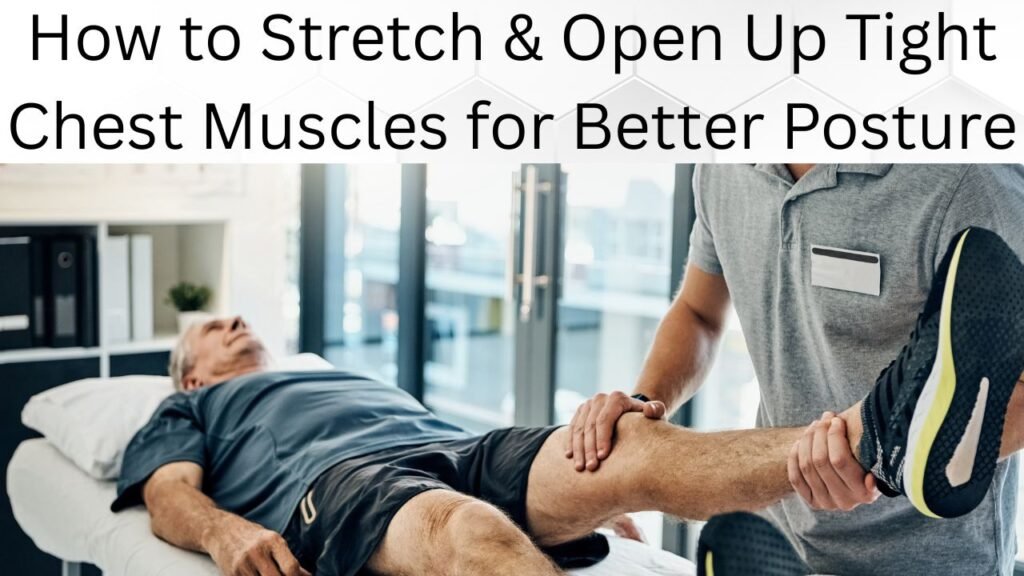Tight chest muscles can pull your shoulders forward, leading to poor posture and discomfort. Whether caused by prolonged sitting, excessive screen time, or strength imbalances, chest tightness affects upper body alignment. Stretching these muscles regularly can restore balance, improve posture, and reduce pain.

Why Chest Muscles Become Tight
The pectoral muscles, including the pectoralis major and minor, play a key role in upper body movement. When they become tight, they pull the shoulders forward, leading to rounded posture and restricted mobility. Common causes of chest tightness include:
- Prolonged sitting with a hunched back
- Excessive use of phones and computers (tech neck)
- Overtraining the chest without balancing back exercises
- Poor sleeping positions
- Stress and muscle tension
Best Stretches to Open Up Tight Chest Muscles
1. Doorway Stretch
A classic stretch that targets both the pectoralis major and minor.
How to Do It:
- Stand in a doorway and place both hands on the frame at shoulder height.
- Step forward slightly until you feel a stretch across your chest.
- Hold for 20-30 seconds and repeat 2-3 times.
Why It Helps: It counteracts the effects of slouching and improves shoulder mobility.
2. Wall Chest Stretch
This stretch isolates one side of the chest at a time for a deeper release.
How to Do It:
- Stand next to a wall and place one hand on it with your arm extended.
- Gently rotate your body away until you feel a stretch.
- Hold for 20-30 seconds per side.
Why It Helps: It effectively loosens tight chest muscles while promoting thoracic spine mobility.
3. Seated Clasped Hands Stretch
A simple yet effective way to open the chest while seated.
How to Do It:
- Sit tall and clasp your hands behind your back.
- Straighten your arms and lift your chest.
- Hold for 20-30 seconds.
Why It Helps: This stretch reverses forward shoulder rounding and strengthens postural support muscles.
4. Foam Roller Chest Opener
Using a foam roller provides a passive stretch and deep muscle release.
How to Do It:
- Lie on a foam roller lengthwise with your arms out to the sides.
- Allow gravity to stretch your chest for 30-60 seconds.
Why It Helps: It enhances flexibility and relaxes tight muscles without excessive strain.
5. Camel Pose (Yoga Stretch)
A great way to open the chest while improving spinal extension.
How to Do It:
- Kneel on the floor with your hands resting on your heels.
- Push your hips forward and lift your chest.
- Hold for 15-20 seconds.
Why It Helps: It stretches the chest and strengthens the lower back, improving posture.
6. Pec Minor Release with a Massage Ball
A deep tissue release technique for stubborn tightness.
How to Do It:
- Place a massage ball against a wall and press it into your upper chest.
- Move in small circles to massage tight areas.
- Do this for 1-2 minutes per side.
Why It Helps: It targets deep muscle knots that static stretching may not release.
Additional Tips for Better Posture
- Strengthen the Upper Back: Focus on exercises like face pulls and rows to balance chest tightness.
- Adjust Your Workstation: Keep your screen at eye level and avoid slouching.
- Take Breaks from Sitting: Stand up and stretch every 30-60 minutes.
- Breathe Properly: Deep breathing expands the chest and reduces tension.
When to Seek Professional Help
If your chest tightness causes pain, limits movement, or leads to chronic discomfort, consider seeing a physical therapist. They can provide a customized stretching and strengthening plan.
Final Thoughts
Stretching your chest muscles is essential for better posture and pain relief. Consistently incorporating these stretches into your routine will help you move more freely, stand taller, and reduce tension caused by daily activities. Prioritize mobility and balance to maintain long-term spinal health.